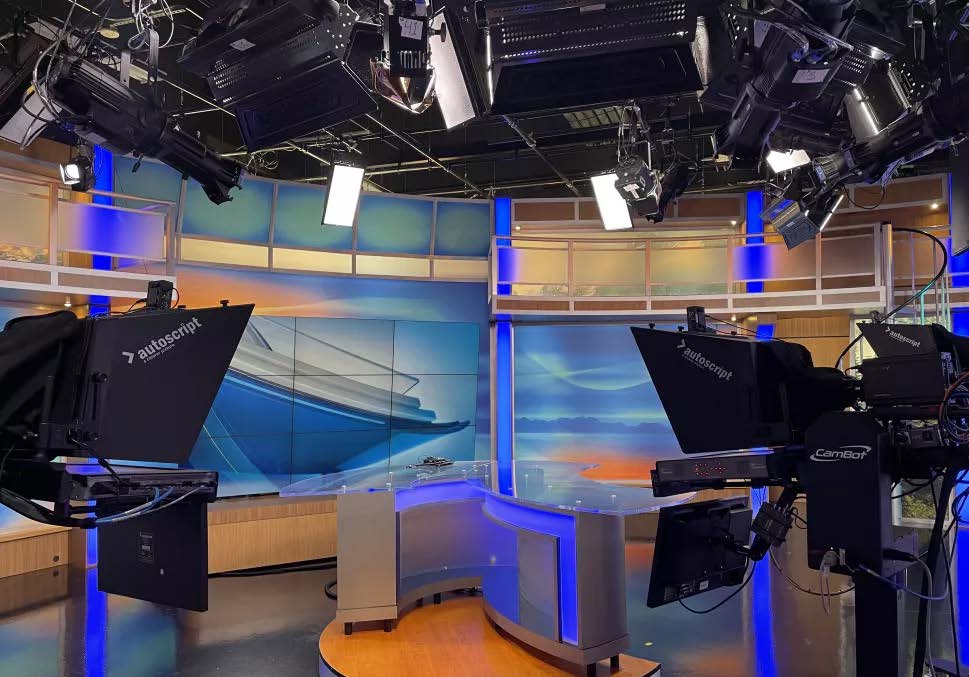Getting power to anything from lighting to video walls should not be an afterthought. Today’s digital
endpoints have added new challenges, putting a spotlight on the need for proper power control and
management.

(Image credit: LynTec )
The TV broadcast news set is foundational to the dissemination of information. Ensuring that news is presented in a clear and engaging way requires not only high-quality cameras, audio equipment, and displays but also lighting. During the last decade, many news stations have transitioned to LED lighting technology because of the many long-term benefits that make them worth the investment and the ability to enhance set design from segment to segment at a touch of button. While their most notable features are their brightness, extensive color capabilities, and less maintenance, LEDs also consume less power and reduce heat loads — a real win for broadcast organizations — but only when properly powered.
The need for proper power control is something Jonathan Huff, CEO and President of Alaska Universal Productions (AUP), understood when Alaska’s News Source, the local NBC affiliate in (city), tapped him to upgrade their studio lighting system. The studio featured two broadcast studios with over a hundred LED lighting fixtures as well as several video walls mounted around the studio that needed reliable, simple, and future-proof power control system.
“The studio was new to Alaska’s News Source, but it was not ready for primetime, so to speak, and they were on a deadline from the FCC to get it up and running,” said Huff. “There were cables going from one side of the studio to the other and then back to get to the light right next to it. The fixtures were DMX controlled, but the original design and preset did not turn the fixtures off completely. And that’s an issue for newer LED technology with computer chips in them. If they’re constantly on 24/7, it ages them unnecessarily.”
Although the fixtures were dimmed down to no longer emit light, power was still flowing to them. That drives up energy costs, continuously generates heat within the fixture which causes their internal fan to kick on constantly. This cycle will not only damage the instruments, but also can wear them out prematurely and unexpectedly increasing maintenance costs.
A Power Control Platform
AUP worked to design a system that would bring the lighting system up to par, giving them clean and simple power control. Because the station airs a show almost every half hour with as little as a two-minute break in between, their primary objectives were to enable fast and efficient lighting presets to support the busy network schedule, eliminate the vast number of cables snaking around the studio, and ensure that the studio’s lighting investment was as functional, energy-efficient, and cost-efficient as possible.
AUP reworked the entire lighting grid, incorporating existing and new lighting for a total of 150 fixtures, which were a mix of ETC Source Four, Philips Selecon PLCyc, and multiple Brightline fixtures. In addition, they installed nearly 1,000 feet of pixel tape. To provide engaging infographics and videos to display during news segments, video walls were incorporated around the facility, including a Samsung 3×3, 2×2, 2×4, and an LED video wall. To turn all that LED equipment on and off, a robust power control platform that was compatible with DMX control was required. Enter LynTec automated power control panels.
“I’ve seen LynTec at trade shows and felt this would be a great product for it,” Huff said.
Working with Matt Skjerven of Image Marketing West, his manufacturer representative, Huff selected two LynTec RPCR-16 Automated Relay Panels for a total of 32 circuits of automated power control for the lighting and video system in the broadcaster’s new studio. The intelligent remotely controlled relay panels manage power to the LED fixtures and grant individual control over every circuit, providing the flexibility that previously would have come from a dimming system. In this way, the lighting control system can cycle power to individual circuits to give an occasional hard reboot to the LED fixtures or to enable service in one area while maintaining lighting in another.
Once the electrician had wired the panels in, all that was left was to plug in the network cable and launch LynTec’s web GUI to set the control options for each circuit. The lighting system was programmed to be controlled from the studio’s lighting console to completely shut down power to the LED fixtures as well as sequence the video walls, ensuring they’re not consuming standby power when not in use and are protected from damaging inrush when powered on.
“Broadcasters like Alaska’s New Source are tasked with delivering the news and can’t afford their systems to go down in the middle of segment, I knew I needed a product that wouldn’t fail. LynTec is super, super simple and reliable,” Huff concluded.

